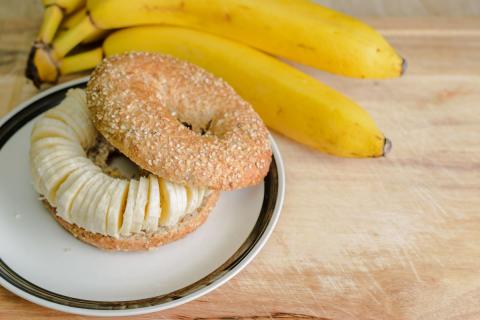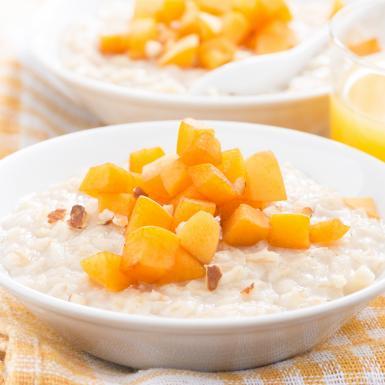- 4 (240g) Flour Tortillas
- 4 (200g) Eggs
- 5 Tablespoons (75ml) Semi-Skimmed Milk
- 1 (85g) Tomato
- 1 (10g) Spring Onion
- 1 (160g) Green Pepper
- 1 Tablespoon (10g) Vegetable Oil
- 8 (80g) Mushrooms
- 1 to taste Pinch (1g) Ground Black Pepper
Ingredients
Allergy Disclaimer
Always check the label of each ingredient for allergy warnings.
Method
- Crack eggs into a bowl and beat together with a fork and stir in the milk.
- Finely chop the tomato, spring onion, pepper and mushrooms.
- Heat quarter of oil in a medium frying pan, pour in quarter of the egg mixture and cook for a few moments before adding quarter of the chopped vegetables to the pan.
- Once the egg has set, slide the omelette onto a tortilla and add black pepper to taste. Repeat for the remaining tortillas.
- Roll up the tortilla once cooled slightly, slice in half and serve or wrap in tin foil to enjoy later.
Time Saver Tips
Can be cooked and then wrap in tin foil to eat on the go.
Cost Saver Tips
Try with other vegetables you have left over.
Tips for Kids
They will enjoy rolling their own wraps. Use their favourite coloured pepper
Nutritional Information
Based on a single serving of 190g (% of an adult's reference intake)
Energy
312 kcals ( 16 %)
1,309 kJ ( 16 %)
Fat
3.8 g ( 19 %)
Saturates
35 g ( %)
Sugar
4 g ( 4 %)
Salt
1 g ( 17 %)
Detailed nutritional information
| Per 100g | Per 190g serving | |
|---|---|---|
| Energy Kcals | 164 | 312 |
| Energy Kj | 689 | 1,309 |
| Protein | 7.2 g | 13.7 g |
| Total Fat | g | g |
| Saturated Fat | 2 g | 3.8 g |
| Carbohydrates | 18.4 g | 35 g |
| Total Sugars | 2.1 g | 4 g |
| NSP Fibre | 1.8 g | 3.4 g |
| Sodium | 183 mg | 348 mg |
| Salt | 0.5 g | 1 g |
Find out about nutritional labelling
Nutrition labels on the front of packaging
- Most of the big supermarkets and many food manufacturers display nutritional information on the front of pre-packed food.
- Front of pack nutrition labels provide information on the number of grams of fat, saturated fat, sugars and salt and the amount of energy (in kJ and kcal) in a serving or portion of a recipe.
- The labels also include information about reference intakes (expressed as a percentage) which are guidelines about the approximate amount of particular nutrients and energy required for a healthy diet.
- The colour coding tells you at a glance if the food has high (red), medium (amber) or low (green) amounts of fat, saturated fat, sugars and salt.
- The more greens on the label, the healthier the choice
- Amber means neither high nor low, so you can eat foods with all or mostly ambers on the label most of the time.
- Reds on the label means the food is high in that nutrient and these are the foods we should cut down on. Try to eat these foods less often and in small amounts.
Food shopping tips
If you’re trying to decide which product to choose, check to see if there's a nutrition label on the front of the pack. This will help you to quickly assess how your choices stack up. You will often find a mixture of red, amber and green colour coding for the nutrients. So when you're choosing between similar products, try to go for more greens and ambers and fewer reds if you want to make a healthier choice.
 Activities & Play
Activities & Play Behaviour
Behaviour Childcare
Childcare Development & Growing Up
Development & Growing Up Family, Friends & Relationships
Family, Friends & Relationships Feeding Your Baby
Feeding Your Baby Food & Eating
Food & Eating Health & Safety
Health & Safety Mental Health & Wellbeing
Mental Health & Wellbeing Money & Work
Money & Work Online Behaviour & Safety
Online Behaviour & Safety Pregnancy & First Days
Pregnancy & First Days School & Education
School & Education Sleep
Sleep



















